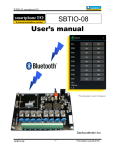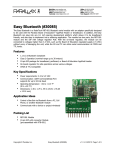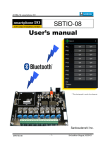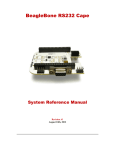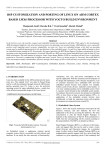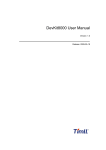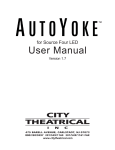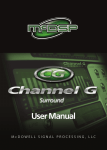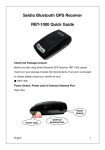Download Muvium Board Manual
Transcript
muvium RBT-DB RoboTech Daughterboard User’s Guide Version 0.1, 9 October 2007 muvium RBT-DB Users Manual 1 RBT-DB.............................................................................................................................. 1 RoboTech Daughterboard................................................................................................... 1 User’s Guide ....................................................................................................................... 1 Introduction......................................................................................................................... 3 Elements of the RBT-DB................................................................................................ 4 RBT-DB Functional Description .................................................................................... 5 Motor Control Drivers ................................................................................................ 5 6 Analog Inputs........................................................................................................... 5 4 Digital Inputs ........................................................................................................... 5 I2C EEPROM DataStore ............................................................................................ 5 Speaker........................................................................................................................ 5 Status LEDS................................................................................................................ 5 4-Way DIP Switch ...................................................................................................... 5 Assembly Instructions......................................................................................................... 6 Step 1: Disconnect Serial Cable.................................................................................. 6 Step 2: Remove JRT-101 ............................................................................................ 6 Step 3: Orientate RBT-DB.......................................................................................... 6 Step 4: Insert the RBT-DB.......................................................................................... 7 Step 5: Attach the Serial Cable ................................................................................... 7 Step 6: Set the Serial Connector for Straight-Thru..................................................... 7 Step 7: Connect Touch Sensors .................................................................................. 8 Step 8: Connect Field Sensors .................................................................................... 8 Step 9: Verify Jumper Settings ................................................................................... 8 Step 10: Verify Motor Wiring Connections................................................................ 8 Step 11: Visually Confirm Setup ................................................................................ 9 Testing your Assembly ..................................................................................................... 10 Default Firmware .......................................................................................................... 10 Test Mode ..................................................................................................................... 10 Step 1: Set the DIP to TestMode............................................................................... 10 Step 2: Connect the Serial Cable .............................................................................. 11 Step 3: Configure HyperTerminal ............................................................................ 11 Step 4: Turn on the Robot......................................................................................... 12 All Firmware Modes ......................................................................................................... 13 AutoCalibrate in Firmware Examples .............................................................................. 14 Schematic.......................................................................................................................... 16 muvium RBT-DB Users Manual 2 Introduction The muvium RoboTech Daughterboard ( RBT-DB) has been created to allow students and other developers to extend the capabilities of the RoboTech RDS-X01 robot and other applications that use the RDC-101 base controller. The extended capabilities include enhanced IO with an additional 4 Digital IO channels, 4 LEDS, a 4 Way DIP switch, a Speaker and also enhanced software capabilities including compatibility with the RoboPAL educational robotics software platform. RBT-DB Photo uVM-2620 ON DIP 1 2 3 4 RBT-DB Diagrammatic muvium RBT-DB Users Manual 3 Muvium Microcontroller Serial Port Connector uVM-2620 DIO0 DIO1 DIO2 Speaker ON 4-Way DIP DIO3 DIP 1 2 3 4 LED (Red) LED (Yellow) LED (Green) LED (Blue) Elements of the RBT-DB Muvium Microcontroller The muvium microcontroller is a java enabled microcontroller that is compatible with the RoboPAL software platform and other tools available from www.muvium.com Serial Port Connector The SerialPort Connector is a 6-PIN JSR socket suitable for connecting directly to the RDR-301 232C Serial Communications Board Speaker Mini Speaker for generating tones and sounds LEDS ( Blue,Green,Yellow,Red) Status LEDS for indicating status and user feedback 4-Way DIP DIP Switch for generating user input DIO(0..3) 4 Digital Input and Output JSR 3-Way connectors suitable for connecting directly to a range of RoboTech connectors including the RDI-801 touch sensor and others. muvium RBT-DB Users Manual 4 RBT-DB Functional Description Referring to the Schematic in the Appendix the RBT-DB has the following functionality when combined with the RDC-101 board. Motor Control Drivers Generates two motor control driver signals on the M1 and M2 pin pairs. This is a HBridge motor control signal which drives the H-Bridge controller on the RDC-101B which in turn generate the power signals to drive the DC motors of the robot. 6 Analog Inputs 6 Analog inputs are available reading from the CN1 to CN6 Input connectors on the RDC-101 board. These are read with a 10-bit accuracy. 4 Digital Inputs 4 Digital inputs are available, DIO1 to DIO4, from the RBT-DB board connectors. DIO1 and DIO2 also offer interrupt detection change detection for rapid response to events such as touching objects. I2C EEPROM DataStore The I2C EEPROM on the RDC-101 is readable and writeable allowing serialized programs or data to be stored and retrieved Speaker The speaker can be used to generate sounds and tones Status LEDS Four status LEDS, Blue, Green, Yellow and Red are used to generate status and user feedback signals during program execution. 4-Way DIP Switch A 4-Way Dip Switch is multiplexed with the status LEDS to allow for further user Input. This is typically used for program and mode selections. muvium RBT-DB Users Manual 5 Assembly Instructions The RBT-DB is a replacement for the JRT-101 microcontroller that ships with the RoboTech RDC-101 Main Controller board. The underside of the RBT-DB has a 16 pin header which inserts into the socket of the JRT-101 when the JRT-101 is removed. Step 1: Disconnect Serial Cable When using the RBT-DB board, the serial cable must be connected to the RBT-DB and not the RDC-101 Main Controller board. If the serial cable is already connected to the RDC-101 it must first be disconnected. The serial cable will then be reconnected with the RBT-DB board in Step 5. Step 2: Remove JRT-101 Using a IC Chip removal tool or carefully with a flat screwdriver remove the JRT-101 from it’s socket on the RDC-101 Main Controller board and store the JRT-101 device somewhere safe. Step 3: Orientate RBT-DB Orientate the RBT-DB board such that the notch on the board faces the left bottom corner of the RDC-101 Main Controller board. There is a tall capacitor in this corner that this notch avoids which can be used as a reference. muvium RBT-DB Users Manual 6 Step 4: Insert the RBT-DB Carefully align the header pins on the underside of the RBT-DB with the empty JRT-101 socket and push the RBT-DB into place. Step 5: Attach the Serial Cable When using the RBT-DB board, the serial cable must be connected to the RBT-DB and not the RDC-101 Main Controller board. Connect now the Serial cable to the RBT-DB board. 1 NOTE: When ever handing the RBT-DB while it is in the socket be sure to secure the board by holding it in one hand while working on it with the other. The connector on the RBT-DB is the same as the connector on the RDC-101 so follow the same procedure as for connecting the serial port to the RDC-101 Main Controller board. Step 6: Set the Serial Connector for Straight-Thru When programming the RBT-DB board with the serial cable you will use the straight through setting on the RD1-301 board. Ensure now the SW1 switch on the RD1-301 board is set to the straight-thru position. muvium RBT-DB Users Manual 7 Step 7: Connect Touch Sensors Connect the two touch sensors. Connect the Left Touch Sensor to the DIO0 socket and connect the Right Touch Sensor to the DIO1 socket. Step 8: Connect Field Sensors The field sensors are connected to the Analog input sensors CN1 and CN2. Connect the Left Field Sensor to CN1 and connect the Right Field Sensor to CN2. Step 9: Verify Jumper Settings Verify the jumper settings on the RDC-101 are as follows • • • • • • • J1 = Jumper B J2 = Jumper A J3 = Jumper A J4 = Jumper B J5 = Jumper A SW2 = ‘R’ Position SW4 = ON Position Step 10: Verify Motor Wiring Connections The RBT-DB drives the motors where M1 is the right motor and M2 is the left motor. Depending on which side the motors are physically connected will determine which wires need to connect to which pins. If your motors are connected with the motor with the yellow and orange wires on the right hand side of the robot, then for correct directional control connect the motor wires as follows. • • • • M1+ connects to the yellow wire M1- connects to the orange wire M2+ connects to the green wire M2- connects to the blue wire If your motors are connected with the motor with the yellow and orange wires on the left hand side of the robot, then for correct directional control connect the motor wires as follows. • • • • M1+ connects to the green wire M1- connects to the blue wire M2+ connects to the yellow wire M2- connects to the orange wire muvium RBT-DB Users Manual 8 Step 11: Visually Confirm Setup Ensure motor wires are connected with the correct orientation. When using the RBTDB board the Serial Cable Connects to the RBT-DB instead of the RDC-101 Main Controller board Left Field Sensor Connects to CN1 Right Field Sensor Connects to CN1 Serial Port is set for Straight-Thru Left Touch Sensor Connects to DIO0 Right Touch Sensor Connects to DIO1 muvium RBT-DB Users Manual 9 Testing your Assembly Programming of the RBT-DB is performed from RoboPAL. See the RoboPAL User Manual for details on how to program the RBT-DB. However the default firmware that ships with the RBT-DB allows you to perform several experiments to verify you have assembled and correctly configured your RBT-DB board. Default Firmware The default firmware contains several features to assist with demonstrations and experimenting with the Robot without having to first program the Robot. Many of the introductory examples from the Basic and Rescue RoboDidactics coursework are embedded in the firmware as are test, program and replay modes. These different modes are discussed later in this section. First though we will look at how to perform a quick test to make sure everything is connected up and working as expected. Test Mode For this test we will switch to TestMode using the DIP switch and then connect to the Robot using the standard Hyperterminal serial communications package. This allows us to test the robot without any special software just to make sure things are working properly. Step 1: Set the DIP to TestMode Turn the Robot off ( SW1 ) and while holding the RBT-DB board securely in place switch the DIP switch to TestMode – All the switches are in the bottom position TestMode DIP Settings muvium RBT-DB Users Manual 10 Step 2: Connect the Serial Cable Connect the Serial Cable to the Robot Serial Connector on the RDI-301 and to your PC. Each computer is handler their serial communications differently. Many have the older style RS232 connector but many newer computers use a USB converter. Also which COMM port you PC will use for the serial connection is unique to your PC. Step 3: Configure HyperTerminal Once you have connected your cable and determined the COM port you can test the configuration using HyperTerminal. You can use any serial communications package but HyperTerminal is bundled with Windows so it should be available. Start HyperTerminal from the windows start menu StartÎProgram FilesÎAccesseriesÎCommunicationsÎHyperTerminal When configuring the Port Settings you need to first select the COMM port you will use and then you need to setup HyperTerminal to use 115200N8 communications. 1 NOTE: RBT-DB Communicates at Baud 115200, Data bits 8, Parity None, Stop Bits 1, FlowControl None muvium RBT-DB Users Manual 11 Step 4: Turn on the Robot You are now ready to run the test. Turn on the Robot and you should see the following test message being continuously updated in the HyperTerminal screen. This test message indicates the current status of the left and right buttons and the left and right field sensors. If you press the left button you should see the status change from ‘F’ to ‘T’ and if you move the robots field sensors you should see the field sensor values change. 1 HINT: You can use the TestMode to tune the value of the POT’s if you are using IR field sensors that use POT’s. muvium RBT-DB Users Manual 12 All Firmware Modes In addition to the TestMode the default firmware supports the following modes. • Refer to the RoboDidactics Basic and Rescue course materials for more information on the pre-stored examples. • Refer to the RoboPAL User Manual for more information on programming using Immediate Mode. DIP SETTING MODE Mode Description Test Mode Prints sensor information to UART – Connect to HyperTerminal to see current Button and Field Values. Useful for verify assembly and for testing and tuning the sensor levels. Executes the Drive Forward Basic Example. This drives forward for 4 seconds and has no AutoCalibrate so it begins immediately upon reset. Execute the Drive until Change Basic Example. Drives forward until a change of the sensors. This has no AutoCalibrate so begins immediately. Executes the AutoCalibrate Circle Example. The first example to use the AutoCalibrate. The blue LED will light up indicating it is ready. ‘PRESS’ the left button to calibrate. The ‘RIGHT’ button to run. Once calibrated pressing run will cause the robot to drive ahead and stop at a black line. Executes the clear the circle example. Requires a circle field. 1 - Drive Forward 2 – Drive until Change 3 – AutoCalibrate Circle 4- Clear Circle 5- Auto calibrate Rescue Attempts to calibrate 3 colors or GreyScale. muvium 6 – Clear Rescue Attempts to calibrate 3 colors or GreyScale and then clear the rescue field. 1 – A First Line Follower The first line follower drives the robot in a roughs square. It has no AutoCalibration RBT-DB Users Manual 13 2 - A Real Line Follower A real line follower follows a line edge with a edge follower. Uses AutoCalibration. 3 – A Faster Line Follower Uses two sensors. Make sure when starting to follow a line that it is started with one of the sensors on the line else it waits. Uses AutoCalibration. Replays the last program programmed in Immediate Mode Replay Mode Immediate Mode Enables programming from RoboPAL. Attempts to loop to allow RoboPAL to be able to reprogram again and again. When programmed successfully the program is stored and can be replayed by switching to replay mode.. AutoCalibrate in Firmware Examples Many examples use AutoCalibration in the program. If AutoCalibrate is used then the blue LED will come on to indicate the program is waiting for either a LEFT button press to calibrate, or a RIGHT button to run. A Button press is performed by touching the touch sensors. You can repeat the calibration procedure if you are not happy with what the robot drove over during the AutoCalibrate procedure by pressing the LEFT button again. The following flow diagram describes the states. POWER ON | RESET Left Button Pressed Blue LED ON Y Yellow LED ON Do Calibrate Run Program END RED LED ON N N muvium Right Button Pressed Y RBT-DB Users Manual 14 The calibration information is stored in an EEPROM so you don’t need to calibrate each time you run a program. Note however that as the battery charge level changes so may the sensor value results hence AutoCalibration makes it easy to compensate for the changing ranges of the sensors due to battery level changes. muvium RBT-DB Users Manual 15 Schematic muvium RBT-DB Users Manual 16
















